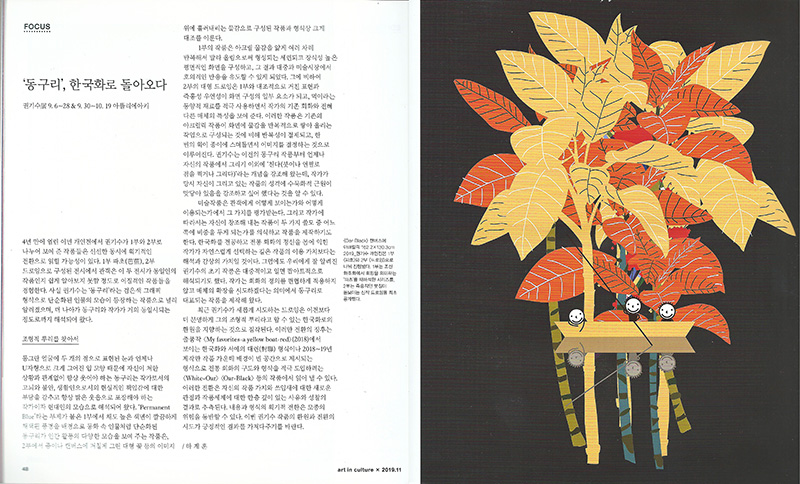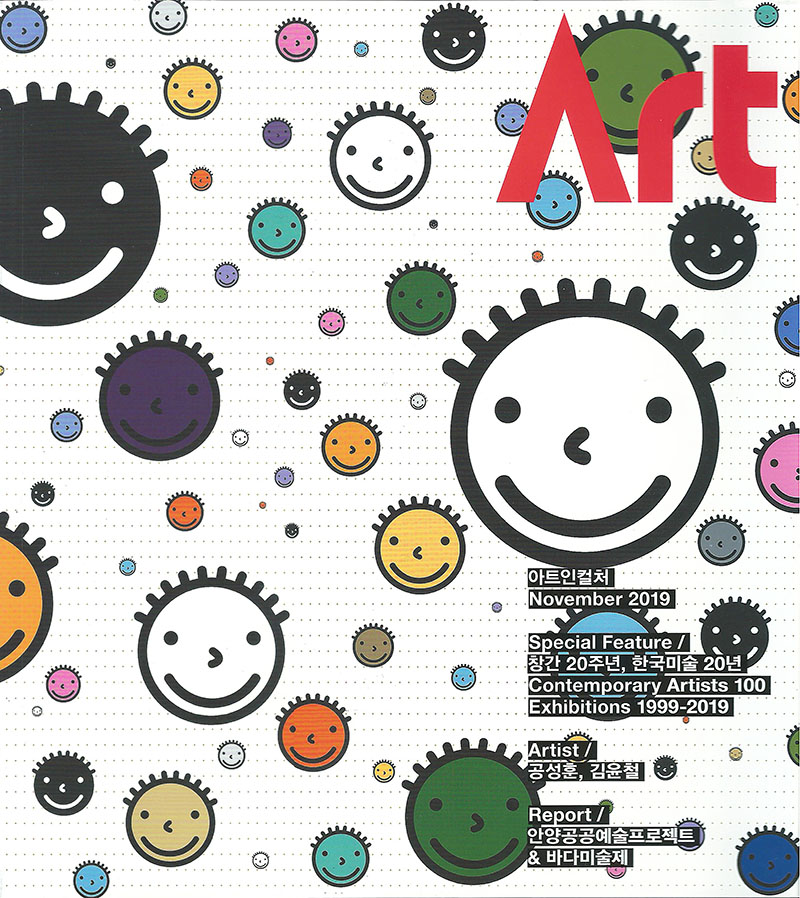Art in Culture
Cover Image & Focus | 2019 Nov.
Cover | Kwon Kisoo , Face 2(detail), 162.1X130.3cm, acrylic on canvas on board, 2019

Oar-Black_162.1X130.3cm_acrylic on canvas on board_2019
Focus
‘Dongguri’ Returns to Korean Painting
Kwon Ki Soo Exhibition
September 6 – 28 & September 30 – October 19
ATELIER AKI
Kwon Ki Soo's works, showcased in two Parts at this solo exhibition—his first in 4 years—, are likely to provide a fresh and innovative turning point. In this exhibition, which consists of the first part ‘Plantain’ and the second part ‘Drawing’, the audience encounters works so distinctly different from one another that it is not easy to accept that they were produced by the same artist. In fact, Kwon Ki Soo is best known for his works that featured a simplified graphic figure in black contours called ‘Dongguri,’ which became so popular that it seemed that Dongguri and its creator would always be synonymous.
In Search of Artistic Roots
Dongguri is a figure that always has to laugh regardless of the situation, because of the eyes depicted by two dots on its round face and the large U-shaped mouth. It has been interpreted as the alter ego of the artist and simultaneously, the contemporary man, who must disguise with a bright smile the anguish and anxiety experienced by the artist and the burden of responsibility on the man in society. The works displayed in Part 1 with the subtitle “Permanent Blue” show Dongguri engaging in various human activities set against the backdrop of a neatly colored high chroma surface. This is quite a contrast to the works in Part 2, in which paint flows over images such as large flowers, roughly drawn on paper or canvas.
The works in Part 1 have sophisticated and highly decorative flat surfaces formed by repeatedly applying thin layers of acrylic paint. Kwon Ki Soo has been showing work featuring the Dongguri character for some time, and has received a favorable response from the public and the art market. In contrast, the large-scale drawings in Part 2 show characteristics that are completely different from the artist’s previous paintings, because the rough rendition as well as spontaneity and contingency form part of the composition of the canvas, and the traditional Oriental art material of Chinese ink has been widely used. Compared to his previous acrylic works, which consisted of thin layers of paint on the surface, these works show a restrained repetitiveness, with a single stroke that permeates the paper defining the overall image. Since the Dongguri series, Kwon Ki Soo has always emphasized the concept of ‘striking’ (dot or draw with a brush or pencil) in addition to drawing in his work, and this indicates that he wanted to emphasize that the works he was drawing at the time were connected to the roots of ink-and-wash painting of the East.
Works of art are valued in terms of how they look to the viewer and how they are used. While creating works, some artists are conscious of which of the two uses he or she is emphasizing. For Kwon Ki Soo, who majored in traditional Korean painting and immersed himself in its ethos, it might be natural to prefer the value of interpretation and appreciation to the usefulness of work. Nevertheless, his early works, which are well known to us, were popular, and in some ways interpreted as pop art. With Dongguri, he did not narrowly apply the definition of painting, but instead attempted to expand the medium.
More clearly than before, Kwon Ki Soo’s most recent work seems to be aiming for a return to traditional Korean painting, which is the root of his art. Signs of this changeover can be sensed in the couplet style of Korean painting and calligraphy in My favorites-a yellow boat-red (2018), or in works such as White-Oar and Oar-Black produced in 2018-19, which show the will to introduce the composition and form of traditional painting by presenting an empty space for the background.
This about-face is presumed to be the result of a new perspective on the value and use of his work, as well as deeper reflections on his art. Fundamental changes in content and form entail some risk. Here’s hoping that Kwon Ki Soo’s attempt at return and change in his work for this exhibition will bring positive results.
HA KYE HOON
FOCUS
‘동구리’, 한국화로 돌아오다
권기수展 9.6-28 & 9.30-10. 19 아뜰리에아키
4년 만에 열린 이번 개인전에서 권기수가 1부와 2부로 나누어 보여준 작품들은 신선한 동시에 획기적인 전환으로 읽힐 가능성이 있다. 1부 파초(芭蕉),2부 드로잉으로 구성된 전시에서 관객은 이 두 전시가 동일인의 작품인지 쉽게 알아보지 못할 정도로 이질적인 작품들을 경험한다. 사실 권기수는 ‘동구리’라는 검은색 그래픽 형식으로 단순화된 인물의 모습이 등장하는 작품으로 널리 알려졌으며, 더 나아가 동구리와 작가가 거의 동일시되는 정도로까지 해석되어 왔다.
조형적 뿌리를 찾아서
동그란 얼굴에 두 개의 점으로 표현된 눈과 언제나 U자형으로 크게 그어진 입 모양 때문에 자신이 처한 상황과 관계없이 항상 웃어야 하는 동구리는 작가로서의 고뇌와 불안, 생활인으로서의 현실적인 책임감에 대한 부담을 감추고 항상 밝은 웃음으로 포장하야 하는 작가이자 현대인의 모습으로 해석되어 왔다. ‘Permanent Blue'라는 부제가 붙은 1부에서 채도 높은 색면이 깔끔하게 채색된 풍경을 배경으로 동화 속 인물처럼 단순화된 동구리가 인간 활동의 다양한 모습을 보여주는 작품은, 2부에서 종이나 캔버스에 거칠게 그린 대형 꽃 등의 이미지 위에 흘러내라는 물감으로 구성된 작품과 형식상 크게 대조를 이룬다.
1부의 작품은 아크릴 물감을 얇게 여러 차례 반복해서 발라 올림으로써 형성되는 세련되고 장식성 높은 평면적인 화면을 구성하고, 그 결과 대중과 미술시장에서 호의적인 반응을 유도할 수 있게 되었다. 그에 비하여 2부의 대형 드로잉은 1부와 대조적으로 거친 표현과 즉흥성 우연성이 화면 구성의 일부 요소가 되고, ‘먹’이라는 동양적 재료를 적극 사용하면서 작가의 기존 회화와 전혀 다른 매체의 특성을 보여준다. 이러한 작품은 기존의 아크릴릭 작품이 화면에 물감을 반복적으로 쌓아 올리는 작업으로 구성되는 것에 비해 반복성이 절제되고, 한 번의 획이 종이에 스며들면서 이미지를 결정하는 것으로 이루어진다. 권기수는 이전의 동구리 작품부터 언제나 자신의 작품에서 그리기 이외에 ‘친다(붓이나 연필로 점을 찍거나 그리다)’라는 개념을 강조해 왔는데, 작가가 당시 자신이 그리고 있는 작품의 성격에 수묵화적 근원이 맞닿아 있음을 강조하고 싶어 했다는 것을 알 수 있다.
미술작품은 관객에게 어떻게 보이는가와 어떻게 이용되는가에서 그 가치를 평가받는다. 그리고 작가에 따라서는 자신이 창조해 내는 작품이 두 가지 쓸모 중 어느 쪽에 비중을 두게 되는가를 의식하고 작품을 제작하기도 한다. 한국화를 전공하고 전통회화의 정신을 몸에 익힌 작가가 자연스럽게 선택하는 길은 작품의 이용 가치보다는 해석과 감상의 가치일 것이다. 그럼에도 우리에게 잘 알려진 권기수의 초기 작품은 대중적이고 일면 팝아트적으로 해석되기도 했다. 작가는 회화의 정의를 편협하게 적용하지 않고 매체의 확장을 시도하겠다는 의미에서 동구리로 대표되는 작품을 제작해 왔다.
최근 권기수가 새롭게 시도하는 드로잉은 이전보다 더 분명하게 그의 조형적 뿌리라고 할 수 있는 한국화로의 환원을 지향하는 것으로 짐작된다. 이러한 전환의 징후는 출품작 <My favorites-a yellow boat-red) (2018)에서 보이는 한국화와 서예의 대련(對聯) 형식이나 2018-19년 제작한 작품 가운데 배경이 빈 공간으로 제시되는 형식으로 전통 회화의 구도와 형식을 적극 도입하려는 <White-Oar) <Oar-Black) 등의 작품에서 읽어 낼 수 있다.
이러한 전환은 자신의 작품 가치와 쓰임새에 대한 새로운 관점과 작품세계에 대한 한층 깊이 있는 사유와 성찰의 결과로 추측된다. 내용과 형식의 획기적 전환은 모종의 위험을 동반할 수 있다. 이번 권기수작품의 환원과 전환의 시도가 긍정적인 결과를 가져다주기를 바란다.
/하계훈
